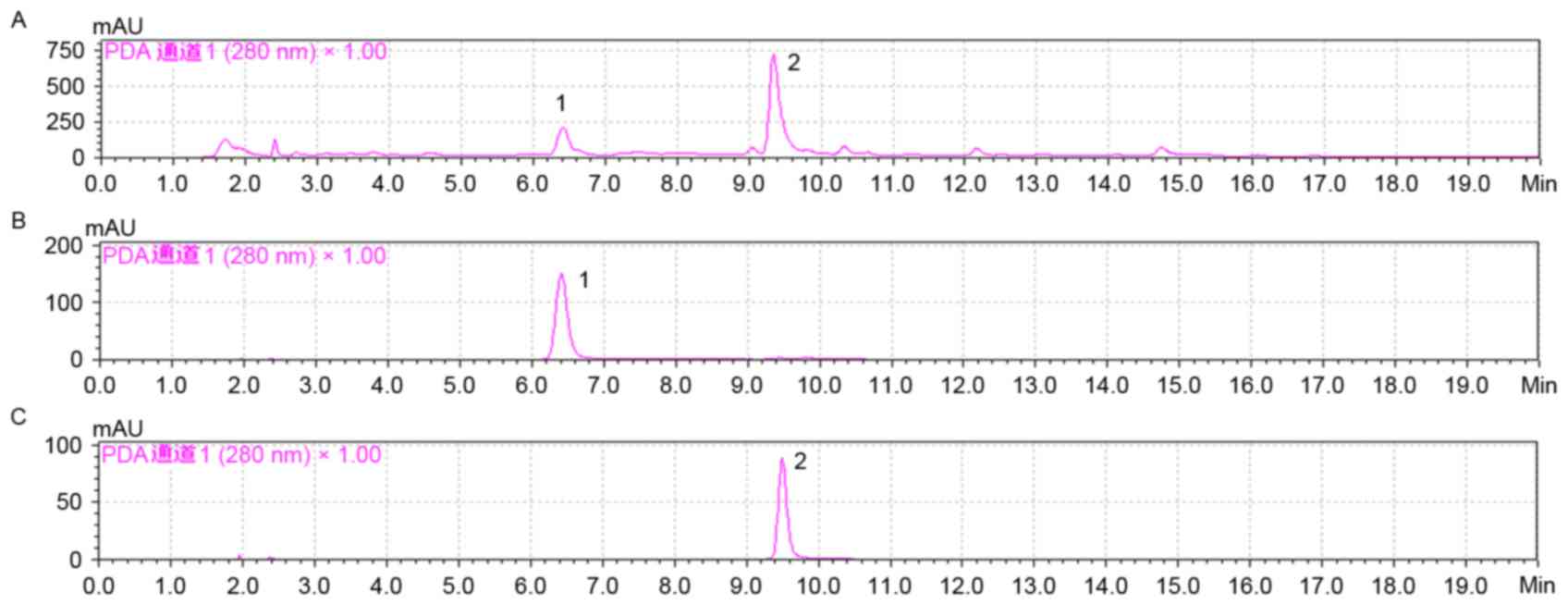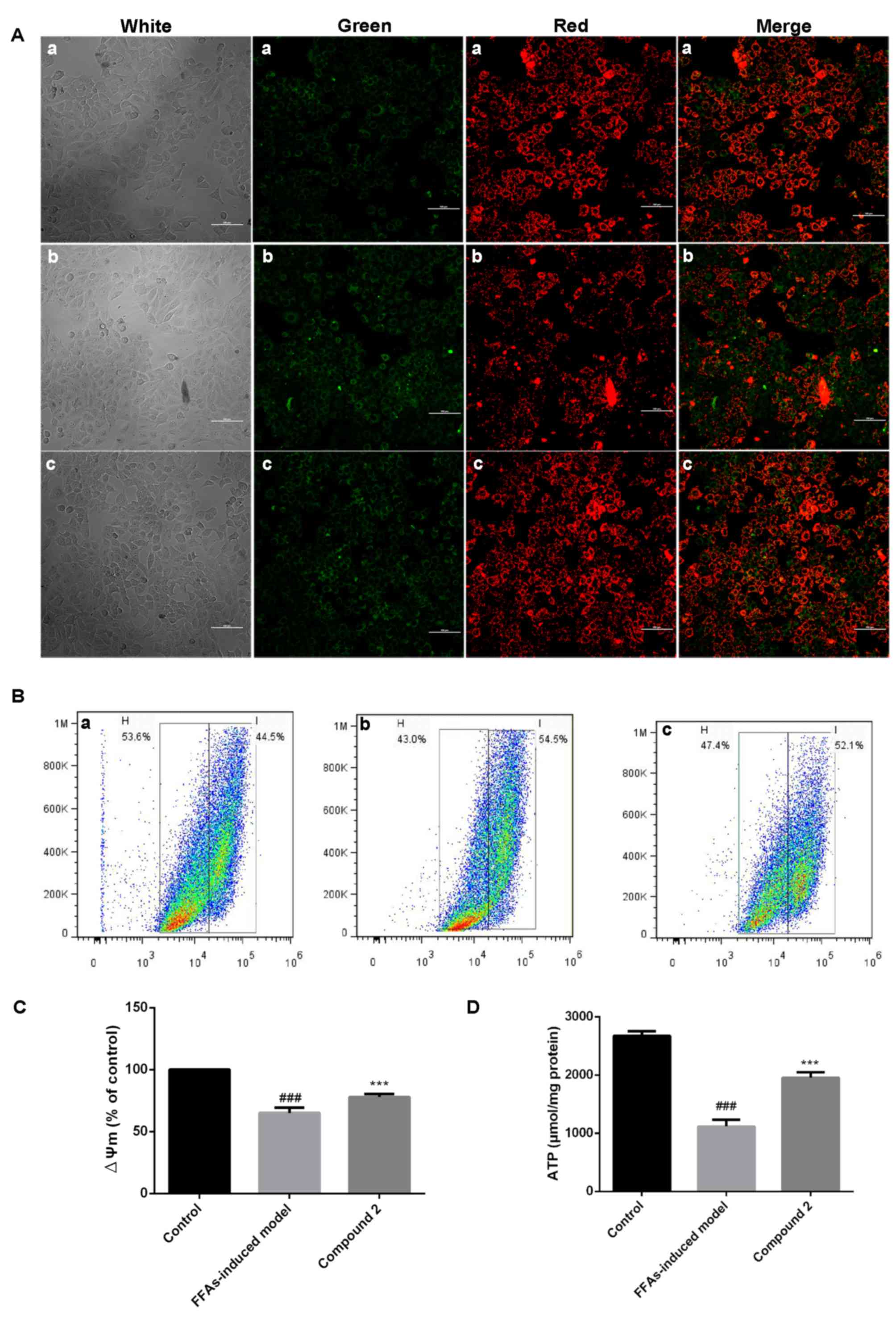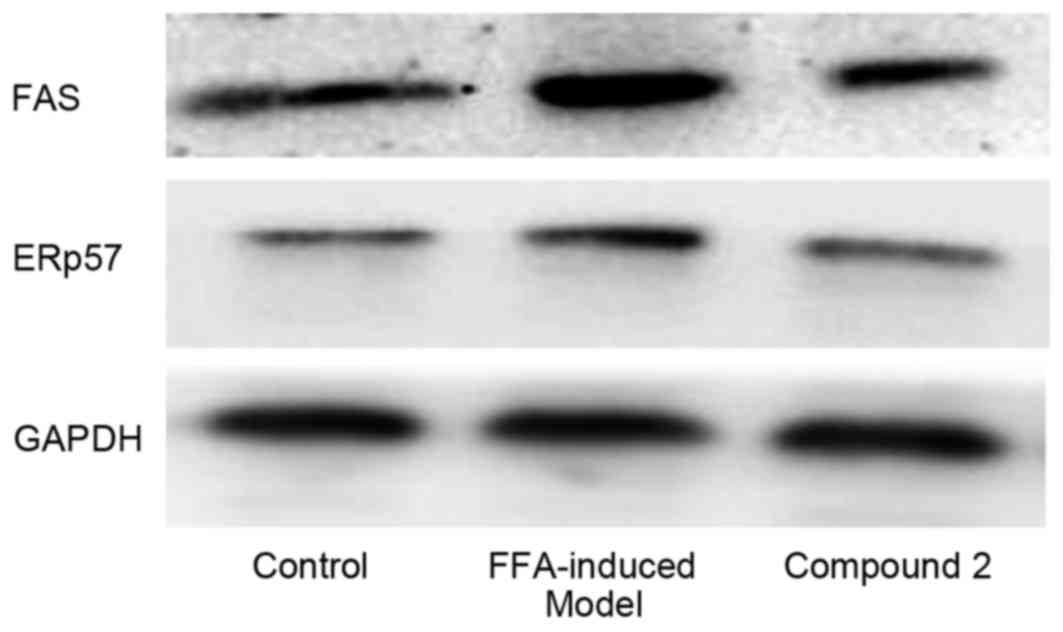|
1
|
Abliz A, Aji Q, Abdusalam E, Sun X,
Abdurahman A, Zhou W, Moore N and Umar A: Effect of Cydonia oblonga
Mill. leaf extract on serum lipids and liver function in a rat
model of hyperlipidaemia. J Ethnopharmacol. 151:970–974. 2014.
View Article : Google Scholar : PubMed/NCBI
|
|
2
|
Cignarella A, Bellosta S, Corsini A and
Bolego C: Hypolipidemic therapy for the metabolic syndrome.
Pharmacol Res. 53:492–500. 2006. View Article : Google Scholar : PubMed/NCBI
|
|
3
|
Luedde T, Kaplowitz N and Schwabe RF: Cell
death and cell death responses in liver disease: Mechanisms and
clinical relevance. Gastroenterology. 147:765–783. 2014. View Article : Google Scholar : PubMed/NCBI
|
|
4
|
Irudayaraj SS, Sunil C, Duraipandiyan V
and Ignacimuthu S: In vitro antioxidant and antihyperlipidemic
activities of Toddaliaasiatica (L) Lam. Leaves in Triton
WR-1339 and high fat diet induced hyperlipidemic rats. Food Chem
Toxicol. 60:135–140. 2013. View Article : Google Scholar : PubMed/NCBI
|
|
5
|
Zhang Y, Shi S, Zhao M, Chai X and Tu P:
Coreosides A-D, C14-polyacetylene glycosides from the capitula of
Coreopsis tinctoria and its anti-inflammatory activity against
COX-2. Fitoterapia. 87:93–97. 2013. View Article : Google Scholar : PubMed/NCBI
|
|
6
|
Zhang Y, Mourboul A and Li ZY: Research
advance in medicinal plants from genus Coreopsis. Zhongguo Zhong
Yao Za Zhi. 38:2633–2638. 2013.(In Chinese). PubMed/NCBI
|
|
7
|
Dias T, Bronze MR, Houghton PJ,
Mota-Filipe H and Paulo A: The flavonoid-rich fraction of Coreopsis
tinctoria promotes glucose tolerance regain through pancreatic
function recovery in streptozotocin-induced glucose-intolerant
rats. J Ethnopharmacol. 132:483–490. 2010. View Article : Google Scholar : PubMed/NCBI
|
|
8
|
Dias T, Liu B, Jones P, Houghton PJ,
Mota-Filipe H and Paulo A: Cytoprotective effect of Coreopsis
tinctoria extracts and flavonoids on tBHP and cytokine-induced cell
injury in pancreatic MIN6 cells. J Ethnopharmacol. 139:485–492.
2012. View Article : Google Scholar : PubMed/NCBI
|
|
9
|
Li YL, Chen X, Xue J, Liu J, Chen X and
Wulasihan M: Flavonoids furom Coreopsis tinctoria adjust lipid
metabolism in hyperlipidemia animals by down-regulating adipose
differentiation-related protein. Lipids Health Dis. 13:1932014.
View Article : Google Scholar : PubMed/NCBI
|
|
10
|
Gong G, Qin Y, Huang W, Zhou S, Wu X, Yang
X, Zhao Y and Li D: Protective effects of diosgenin in the
hyperlipidemic rat model and in human vascular endothelial cells
against hydrogen peroxide-induced apoptosis. Chem-Biol Interact.
184:366–375. 2010. View Article : Google Scholar : PubMed/NCBI
|
|
11
|
El-Demerdash FM and Nasr HM: Antioxidant
effect of selenium on lipid peroxidation, hyperlipidemia and
biochemical parameters in rats exposed to diazinon. J Trace Elem
Med Bio. 28:89–93. 2014. View Article : Google Scholar
|
|
12
|
Miri R, Saadati H, Ardi P and Firuzi O:
Alterations in oxidative stress biomarkers associated with mild
hyperlipidemia and smoking. Food Chem Toxicol. 50:920–926. 2012.
View Article : Google Scholar : PubMed/NCBI
|
|
13
|
Zarzecki MS, Araujo SM, Bortolotto VC, de
Paula MT, Jesse RJ and Prigol M: Hypolipidemic action of chrysin on
Triton WR-1339-induced hyperlipidemia in female C57BL/6 mice.
Toxicol Rep. 1:200–208. 2014. View Article : Google Scholar
|
|
14
|
Kim JS, Kang OJ and Gweon OC: Comparison
of phenolic acids and flavonoids in black garlic at different
thermal processing steps. J Funct Foods. 5:80–86. 2013. View Article : Google Scholar
|
|
15
|
Gerhäuser C, Klimo K, Heiss E, Neumann I,
Gamal-Eldeen A, Knauft J, Liu GY, Sitthimonchai S and Frank N:
Mechanism-based in vitro screening of potential cancer
chemopreventive agents. Mutat Res 523–524. 163–172. 2003.
View Article : Google Scholar
|
|
16
|
Hajiaghaalipour F, Kanthimathi MS, Sanusi
J and Rajarajeswaran J: White tea (Camellia sinensis) inhibits
proliferation of the colon cancer cell line, HT-29, activates
caspases and protects DNA of normal cells against oxidative damage.
Food Chem. 169:401–410. 2015. View Article : Google Scholar : PubMed/NCBI
|
|
17
|
Grespan R, Aguiar RP, Giubilei FN, Fuso
RR, Damião MJ, Silva EL, Mikcha JG, Hernandes L, Amado C Bersani
and Cuman RK: Hepatoprotective effect of pretreatment with Thymus
vulgar is Essential Oil in experimental model of
acetaminophen-induced injury. Evid Based Complement Alternat Med.
2014:9541362014. View Article : Google Scholar : PubMed/NCBI
|
|
18
|
Seo MS, Hong SW, Yeon SH, Kim YM, Um KA,
Kim JH, Kim HJ, Chang KC and Park SW: Magnolia officinalis
attenuates free fatty acid-induced lipogenesis via AMPK
phosphorylation in hepatocytes. J Ethnopharmacol. 157:140–148.
2014. View Article : Google Scholar : PubMed/NCBI
|
|
19
|
Cui W, Chen SL and Hu KQ: Quantification
and mechanisms of oleic acid-induced steatosis in HepG2 cells. Am J
Transl Res. 2:95–104. 2010.PubMed/NCBI
|
|
20
|
Sung DK, Chang YS, Kang S, Song HY, Park
WS and Lee BH: Comparative evaluation of hypoxic-ischemic brain
injury by flow cytometric analysis of mitochondrial membrane
potential with JC-1 in neonatal rats. J Neurosci Methods.
193:232–238. 2010. View Article : Google Scholar : PubMed/NCBI
|
|
21
|
Gyamfi D, Everitt HE, Tewfik I, Clemens DL
and Patel VB: Hepatic mitochondrial dysfunction induced by fatty
acids and ethanol. Free Radic Biol Med. 53:2131–2145. 2012.
View Article : Google Scholar : PubMed/NCBI
|
|
22
|
Pan J, Zhang S, Yan L, Tai J, Xiao Q, Zou
K, Zhou Y and Wu J: Separation of flavanone enantiomers and
flavanone glucoside diastereomers from Balanophora involucrata
Hook. F. by capillary electrophoresis and reversed-phase
high-performance liquid chromatography on a C18 column. J
Chromatogr A. 1185:117–129. 2008. View Article : Google Scholar : PubMed/NCBI
|
|
23
|
Zhang Y, Shi S, Zhao M and Tu P: Novel
chalcone from Coreopsis tinctoria Nutt. Biochem Systemat Ecol.
34:766–769. 2006. View Article : Google Scholar
|
|
24
|
Czakó L, Szabolcs A, Vajda A, Csáti S,
Venglovecz V, Rakonczay Z Jr, Hegyi P, Tiszlavicz L, Csont T, Pósa
A, et al: Hyperlipidemia induced by a cholesterol-rich diet
aggravates necrotizing pancreatitis in rats. Eur J Pharmacol.
572:74–81. 2007. View Article : Google Scholar : PubMed/NCBI
|
|
25
|
Feng LJ, Yu CH, Ying KJ, Hua J and Dai XY:
Hypolipidemic and antioxidant effects of total flavonoids of
Perilla frutescens leaves in hyperlipidemia rats induced by
high-fat diet. Food Res Int. 44:404–409. 2011. View Article : Google Scholar
|
|
26
|
Neuschwander-Tetri BA: Hepatic
lipotoxicity and the pathogenesis of nonalcoholic steatohepatitis:
The central role of nontriglyceride fatty acid metabolites.
Hepatology. 52:774–788. 2010. View Article : Google Scholar : PubMed/NCBI
|
|
27
|
Zhao Y, Peng L, Lu W, Wang Y, Huang X,
Gong C, He L, Hong J, Wu S and Jin X: Effect of Eclipta prostrata
on lipid metabolism in hyperlipidemic animals. Exp Gerontol.
62:37–44. 2015. View Article : Google Scholar : PubMed/NCBI
|
|
28
|
Wu X, Zhang L, Gurley E, Studer E, Shang
J, Wang T, Wang C, Yan M, Jiang Z, Hylemon PB, et al: Prevention of
free fatty acid-induced hepatic lipotoxicity by
18beta-glycyrrhetinic acid through lysosomal and mitochondrial
pathways. Hepatology. 47:1905–1915. 2008. View Article : Google Scholar : PubMed/NCBI
|
|
29
|
Schönfeld P, Więckowski MR, Lebiedzińska M
and Wojtczak L: Mitochondrial fatty acid oxidation and oxidative
stress: Lack of reverse electron transfer-associated production of
reactive oxygen species. Biochim Biophys Acta. 1797:929–938. 2010.
View Article : Google Scholar : PubMed/NCBI
|
|
30
|
Schönfeld P and Wojtczak L: Fatty acids as
modulators of the cellular production of reactive oxygen species.
Free Radic Biol Med. 45:231–241. 2008. View Article : Google Scholar : PubMed/NCBI
|
|
31
|
Wang H, Chan PK, Pan SY, Kwon KH, Ye Y,
Chu JH, Fong WF, Tsui WM and Yu ZL: ERp57 is up-regulated in free
fatty acids-induced steatotic L-02 cells and human nonalcoholic
fatty livers. J Cell Biochem. 110:1447–1456. 2010. View Article : Google Scholar : PubMed/NCBI
|
|
32
|
Menendez JA and Lupu R: Fatty acid
synthase and the lipogenic phenotype in cancer pathogenesis. Nat
Rev Cancer. 7:763–777. 2007. View
Article : Google Scholar : PubMed/NCBI
|















